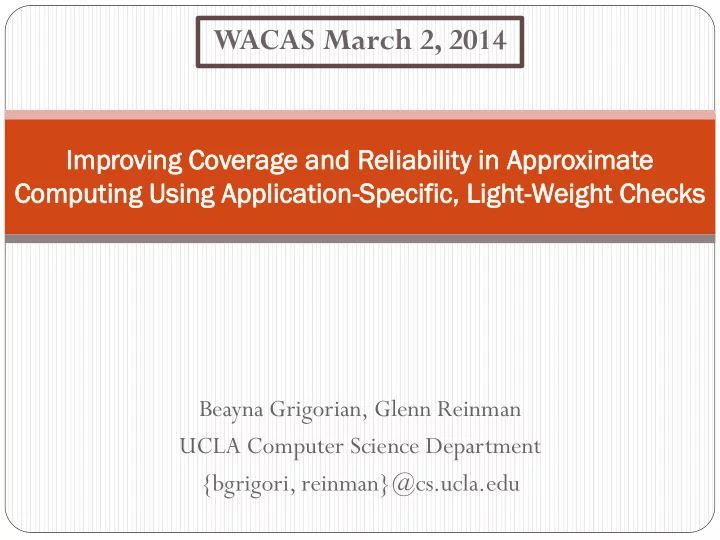

WACAS March 2, 2014 Impr provin ving g Cover erage age an and d Rel elia iabil ilit ity y in in App pproxi xima mate e Computin mputing g Usin ing Ap g Appl plic icati tion on-Sp Spec ecif ific, ic, Lig ight-Wei eight ght Chec ecks ks Beayna Grigorian, Glenn Reinman UCLA Computer Science Department {bgrigori, reinman}@cs.ucla.edu
Introduction Existing Approaches : Application quality is often coupled with the accuracy of the unit of approximation (i.e. approximate accelerator) + Efficient quality analysis using offline, static techniques Potential compromise of coverage and reliability Cases that potentially result in Cannot provide absolute unacceptably inaccurate solutions guarantees for satisfying are exempted from approximation QoS constraints Our Approach : Leverage high-level, application-specific metrics, or Light-Weight Checks , for dynamic error analysis and recovery
Light-Weight Check (LWC) Key Insight : While finding a solution may be complex, checking the quality of that solution could be simple Characteristics Light-weight to evaluate (relative to application) Usage at runtime: Test approximated output and initiate recovery if needed Application-specific , yet algorithm-independent E.g. Scene analysis for physics-based simulation Benefits Reliable, dynamic guarantees on user-specified QoS Better coverage for potentially good approximations Platform-agnostic with negligible overhead
Application Examples Application Sample Algorithm Application Domains LWC Inverse Cycle Coordinate Robotics, Gaming, Forward Kinematics Descent Graphics Kinematics State Kalman Filter Navigation, Finance, Measurement Estimation Signal Processing Comparison Physics-Based Gilbert-Johnson- Fluid Dynamics, Energy Simulation Keerthi Distance Control Systems, Conservation Algorithm Gaming Image Total Variation Computer Vision, Universal Image Denoising Minimization Medical Imaging Quality Index (UIQI)
Implementing LWCs How do I find an LWC? How do I use an LWC? • LWCs are user-defined • LWC is integrated directly into the application • LWCs could be based on: • Code is modified to execute – Internal values (i.e. inputs, approximated outputs, and the following: intermediate values) (1) Call approximate accelerator – External values (e.g. mobile (2) Evaluate LWC; determine QoS robot application with (3) If QoS constraint is not met : supplemental sensory feedback) Initiate recovery • Certain application categories Reprocess current input may have easy-to-identify with exact computation and/or reusable LWCs (4) Continue to next input – Iterative refinement applications – Image processing applications
Implementing LWCs How do I find an LWC? How do I use an LWC? • LWCs are user-defined • LWC is integrated directly into the application • LWCs could be based on: • Code is modified to execute – Internal values (i.e. inputs, approximated outputs, and the following: intermediate values) (1) Call approximate accelerator – External values (e.g. mobile (2) Evaluate LWC; determine QoS robot application with (3) If QoS constraint is not met : supplemental sensory feedback) Initiate recovery • Certain application categories Reprocess current input may have easy-to-identify with exact computation and/or reusable LWCs (4) Continue to next input – Iterative refinement applications Compiler support? – Image processing applications
Experimental Setup Benchmark: Inverse Kinematics (3-joint arm) Error : Distance from end effector to target location Error Tolerance Threshold : maximum percentage of error the user is willing to accept for any application output Approximation : Software-based Neural Network (8x8) Schemes ORIG_1% – orig. benchmark (1% set threshold) A. ORIG_n% – orig. benchmark (adjustable threshold) B. ACC+LWC – benchmark integrated w/ NN & LWC C. ACC-LWC – benchmark integrated w/ NN & no LWC D.
Results: Performance
Results: Reliability • ACC-LWC: No LWC No dynamic reliability! • Significant portions of data are subject to failed QoS
Results: Coverage for Out-of-Range Inputs
Results: Coverage w/ Less Accurate Approx.
Conclusion • Main Idea: Leverage application-level tolerance of imprecision to improve coverage and reliability • Approach: Perform online error analysis and recovery based on LWCs • Platform-agnostic in nature, LWCs allow for an elegant solution to dynamic error control
Questions? Thank you!
Recommend
More recommend